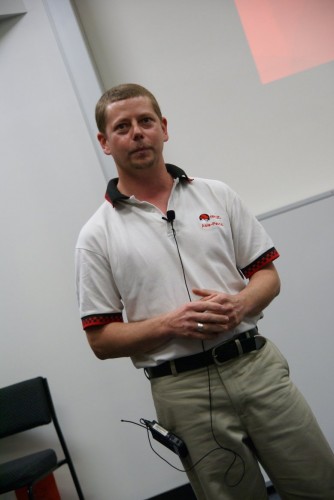This is a live blog post, and will be updated as the talk continues.
Open source can provide an excellent foundation for building businesses, as we’ve seen from many companies past and present.
But how does one utilize the tools and benefits of Open Source to create a successful business model and a sustainable company?
I’m at a talk titled Building successful and unsuccessful businesses on open source foundations, hoping to find out.
Paul Gampe from Red Hat has started off the talk. With over 3000 employees and 66 offices in over 33 countries, Red Hat is a perfect example of how an open source model can benefit a business.
Open Source in Asia is booming
Linux adoption in the Asia-Pacific region has grown significantly in the last year, with 15 percent of the region’s companies having servers that run on Linux.
The open source advantage in Asia:
- Lower barrier to entry for regional development
- Input method software for open source software increasing
- IPv6 development on Linux mostly occurring outside USA
- Asian language font technology developed locally
As you all should know, IPv4 addresses are likely to run out soon.
A lot of the technology for IPv6 was developed by the Japanese, so there is a high demand for IPv6 in Asia.
In particular, Open Source is seeing a large growth in China, Japan and Korea due to a number of factors.
- Linux adoptions is part of China’s renewed drive to use legal software
- Growing adoption of the GPL for publishing software
- Japan is a strong exporter of Open Source technologies
- Government financial and legal support for Open Source companies
- Large Linux adoption on embedded devices in Korea
There is strong government support for open source software throughout Asia, and “governments have a lot of money.”
Gampe is talking now about Red Hat in Brisbane, and specifically what Red Hat does for the state of Queensland in Australia.
Red Hat provides a lot of support for Asia, catering to the high demand in that market as mentioned above.
Making use of a multi-cultural country, Australia is a perfect location for the Asian-Pacific branch of Red Hat – many employees speak multiple languages, and localization and internationalization is prevalent within the branch.
Bandwidth in Asia is a sought after commodity, with many locations having very little bandwidth and being charged exorbitant prices. For example, in Europe, Red Hat employees may suggest to clients to download an instructional DVD – but in Asia, it’s cheaper to package it and send it via snail mail.
Gampe summarizes that Red Hat in Australia has many advantages. Thanks to a multi-cultural society and timezone advantages, their base in Brisbane caters well to the high demand for Linux in emerging markets such as China, Korea and Japan.
With over 100 employees in the Red Hat Brisbane Office, the company branch here is still growing and plans to open up a new floor this year.
Follow Benjamin on Twitter for the latest LCA2011 updates, photos and impressions.
For more LCA2011 photos, check out our Linux.conf.au album on our Facebook fan page.







